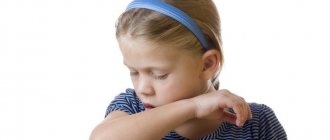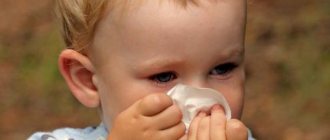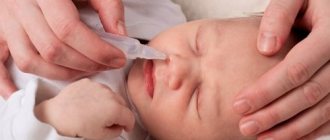The most difficult test for parents of a baby is a sick child. Especially if the disease is accompanied by attacks of intense coughing, reminiscent of a dog barking. In this article, we will consider what provokes a barking cough in a baby, why this reflex is dangerous, and what measures should be taken to eliminate it.
Reasons for appearance
Coughing is a protective reflex, which is a forced exhalation through the oral cavity, causing muscle contraction of the airways due to irritation of the receptors. The physiological purpose of a cough is to clear the respiratory tract of sputum, mucus and other irritating agents, as well as foreign bodies (food debris, small objects, etc.).
Depending on the nature and amount of discharge, a distinction is made between dry (non-productive) and wet (productive) cough. Children (usually between four months and three years old) often suffer from a dry, paroxysmal cough accompanied by sounds similar to a barking dog. This led to the name of the disease - barking cough.
Typically, this symptom accompanies viral pathologies of the upper/lower respiratory tract. A nonproductive cough is the result of inflammatory processes in the nasopharynx, larynx, trachea, bronchi or lungs. Since the baby’s respiratory organs are still imperfect - a narrow larynx, the entry of an infectious agent provokes swelling and inflammation, as a result of which thickening/swelling of the mucous membrane of the trachea and larynx is observed, leading to an even greater narrowing of the lumen of the respiratory tract.
As a result, breathing becomes difficult. In addition, the body, in an attempt to cope with the virus, releases exudate, further preventing the free passage of air. The receptors in the mucous membranes are irritated, which leads to a barking cough, hoarseness, nasal congestion, and increased body temperature (this symptom may not appear).
As a child grows, the lungs and airways develop. Dry cough appears less frequently.
The child has a sudden cough
When a child suddenly starts coughing, it means that food or liquid has gone down the wrong throat. The second option: a foreign object gets stuck (a piece of food, vomit, a small plastic toy, a coin, etc.).
Coughing is the body’s natural way of getting rid of an irritant. Usually everything goes away after a minute or a minute and a half. However, if this does not happen, the baby continues to cough, it is difficult for him to breathe - immediately call an ambulance.
Do not try to clear your baby's throat with your finger, as this may push the object further down the throat.
Barking cough without fever: causes
There are often cases when a dry cough appears, but other symptoms of the disease are not observed. Body temperature remains normal. In this case, we are talking about a non-infectious cough. Experts name the following reasons that provoke it.
Foreign bodies entering the respiratory tract
These could be: small toy parts, leftover food, pieces of bread. You should not give your baby small objects to play with, and it is also important to carefully ensure that there are no toys with small parts that can easily separate in the room or crib.
Symptoms depend on the size of the foreign body. A small object makes itself known by bouts of barking cough, sometimes with the appearance of purulent sputum, and difficulty breathing. In this case, you need to immediately turn the child onto his stomach and tap him on the back with the edge of your palm.
Large foreign bodies cause severe fear, blueness of the face, and wheezing. The baby becomes restless, rushes about, and within 2-3 minutes may fall into a coma. If not treated promptly, this can lead to death.
Allergic reaction
The body of a small child is characterized by increased sensitivity to external stimuli. An allergen can be animal fur, flowering plants, food, polluted air, cigarette smoke.
Dry air
Increased dryness of the air can also cause attacks of dry cough. Therefore, you need to regularly monitor this: ventilate the room, carry out wet cleaning of the room, and, if necessary, purchase an air humidifier.
Physiology
An infant under one year of age may develop a physiological cough caused by natural causes: it clears the airways. Neonatologists claim that such a useful reflex can be observed in infants up to 15-20 times a day. This is normal.
Cough due to a cold in a child
Most colds, from acute respiratory viral infections to bronchitis, cannot be avoided without a cough. It can be either dry or wet. Usually this is part of the general symptoms and goes away along with other signs of the disease.
A cough with fever, runny nose, fever and sore throat clearly indicates ARVI.
However, if the temperature rises to 39 C° or higher, this indicates more serious problems: pneumonia or sore throat. Pay attention to the general condition of the baby (especially if he is less than 12 months old): rapid, rapid breathing, severe lethargy - symptoms of a serious illness! Call your doctor immediately.
Major diseases accompanied by barking cough
A barking cough in a child is most often a symptom of some kind of respiratory disease. Let's take a closer look at what diseases provoke a nonproductive cough.
Laryngitis
Laryngitis - inflammation of the mucous membrane of the larynx - is a common pathology in children under 3 years old, associated with the anatomical features of the body.
Provocateurs - viruses and allergens, as well as genetic predisposition, incorrect use of the spray, unstable psycho-emotional state
The pathology manifests itself suddenly: at night, a healthy child is attacked by frequent bouts of barking cough, accompanied by wheezing in the upper respiratory system. Breathing is shallow, the child's temperature rises.
Pharyngitis
Pharyngitis is an inflammatory process of the laryngeal mucosa and lymphoid tissue caused by pathogenic microorganisms. Other diseases can provoke and activate pathology, for example, caries, inflammation of the nasopharynx, and allergies.
It is accompanied by a strong sore throat, against which a barking cough appears after a while. In infants, pharyngitis leads to swelling of the mucous membrane, spasms and suffocation.
OSLT is acute stenosing laryngotracheitis, or so-called false croup, which occurs against the background of a viral infection. Children who have previously suffered from neurodermatitis, allergies, and diathesis are more susceptible to this pathology.
Laryngeal stenosis manifests itself with a dry barking cough, hoarseness of voice (may disappear altogether), and febrile temperature.
Influenza, ARVI, adenoviruses
These pathologies of viral etiology are accompanied by the following signs:
- hyperthermia;
- pale skin;
- frequent (exhausting) non-productive barking cough;
- breathing accompanied by whistling (especially when inhaling);
- hoarseness;
- attacks of suffocation at night.
Diphtheria
Diphtheria is an acute infection caused by the diphtheria bacillus. It is transmitted by airborne droplets, as well as through household items, and is characterized by a severe course.
Foci of infection occur in the oropharynx, on the skin, eyes, genitals, and ears.
From the age of 3 months, children receive preventive vaccinations.
Diphtheria is characterized by an acute onset: a sharp increase in temperature, pain in the throat, the formation of a gray-yellow coating on the tonsils with clear boundaries, and enlarged lymph nodes.
In children, the pathology is dangerous due to the development of true croup. Its first signs are a barking cough and whistling breathing. If assistance is not provided in a timely manner, asphyxia (suffocation) may occur.
Whooping cough
Whooping cough is an infection caused by the bacterium Bordetella pertussis. Affects the mucous membranes of the respiratory tract.
Infection occurs through airborne droplets upon contact with a carrier of the virus.
A strong non-productive barking cough, often ending in vomiting and accompanied by hemorrhage into the mucous membranes, is the first sign of pathology. The pathology is also accompanied by severe headaches and mucus discharge from the sinuses.
Asthma
Bronchial asthma is a chronic pathology characterized by bronchospasm. Occurs against the background of allergies.
Asthma is accompanied by a dry barking cough, wheezing, and severe attacks of suffocation.
A paroxysmal barking cough can appear due to developmental defects of the respiratory system, pathologies of the cardiovascular and digestive systems, the formation of tumors in the respiratory organs, disorders of the nervous system, burns, and helminthic infestations.
Cough in children under 6 months
For infants under 6 months of age, coughing can be extremely debilitating, so monitor their well-being closely.
Infants are among the population cohort most at risk for complications from respiratory syncytial virus (RSV)
. It provokes cold symptoms and ear inflammation in older children and adults, but in infants more serious consequences are possible: pneumonia, bronchiolitis, etc.
The danger of RSV is that it starts out like a common cold, however, the symptoms quickly develop into a severe cough, breathing problems and wheezing in the chest.
In advanced cases, the child requires emergency hospitalization and connection to a ventilator.
Why is a barking cough dangerous?
Readers of Ogrudnichke.ru recommend:
— Review of the most popular vitamin supplements for children from Garden of Life Read the article >>>
— How can Earth Mama products help young parents care for their babies? Read the article
— Dong Quai is an amazing plant that helps maintain youth in the female body Read more…
— Vitamin complexes, probiotics, omega-3 from Garden of Life, designed specifically for pregnant women Find out more >>>
A dry cough is, first of all, dangerous because inseparable sputum accumulates in the lungs and the infection is not cleared from them. This condition can lead to serious consequences.
A barking cough can be a sign of a serious condition that can be fatal. Immediate medical attention is needed if your child develops a dry cough and a number of other symptoms:
- breathing accompanied by wheezing;
- severely irritated throat;
- fainting, lethargy;
- difficulty breathing, swallowing, speaking (attacks of suffocation);
- excessive salivation;
- cyanosis - blueness of the skin, lips, nails;
- muscle weakness;
- purulent and bloody discharge when coughing;
- hoarseness or loss of voice;
- resistance to treatment.
An immediate visit to a pediatrician to determine the true cause of the cough and timely, systematic treatment will prevent the development of complications. Severe consequences of a long-term nonproductive cough can include pneumothorax, laryngeal stenosis, occlusion, and even death caused by respiratory arrest.
Whooping cough in a child
A rather specific and difficult to reproduce type of cough occurs with whooping cough. In fact, this sound occurs in paroxysms when a child tries to take a deep breath after several episodes of coughing in a row.
If your child inhales sharply after a fit (which sounds like a big "whoop"), this is likely a sign of whooping cough. You should be especially wary if you have not received a comprehensive diphtheria/tetanus/whooping cough (DTP) vaccination.
Babies usually do not make a harsh sound after prolonged coughing episodes. This is dangerous because their lungs at this moment are poorly supplied with oxygen, which can lead to respiratory arrest.
Call a doctor immediately if you suspect your child has whooping cough!
Basic principles of treatment
Self-medication of a barking cough in a newborn is unacceptable. When this protective reflex appears in a baby, you should definitely seek advice from a pediatrician, since it can be physiological (an indicator of normality), as well as evidence of the development of a serious pathology.
However, parents can alleviate the baby’s condition when a dry cough appears. To do this, you must use the following recommendations from experts;
- Regular (at least twice a day) ventilation of the room and maintaining the air temperature within 20-22 degrees Celsius.
- Maintaining an optimal level of humidity (especially during the heating season) using a humidifier or improvised means. For example, placing containers of water on the radiator, hanging wet sheets, spraying with a spray bottle.
- Compliance with drinking regime. To prevent dehydration, you need to give your baby something to drink often (especially if the body temperature is high). It is worth giving preference to drinking water, juices, fruit drinks, and herbal tea.
- Regular walks in the fresh air are beneficial as they help open the lungs.
- Light massage stroking the back will help improve sputum separation.
- Inhalation with a nebulizer in the absence of fever. Saline solution (5 ml) is ideal as a solution for inhalation. Inhaling saline will moisten the mucous membranes of the respiratory tract and reduce the viscosity of sputum.
Diagnosis and possible complications
Diagnosis of barking cough in children as a symptom is simple. The doctor assesses the nature of the sign, establishes the absence of expectoration, and conducts auscultation (using a phonendoscope). Dry rales may be present in the lungs.
To carry out successful treatment, it is important to accurately establish the cause of the corresponding symptom.
Procedures used for diagnosis:
- examination of the child’s oropharynx;
- X-ray examination of the chest organs;
- laboratory blood tests (general, biochemical);
- culture of oropharyngeal swabs to determine the type of bacteria causing the problem.
Diagnosis of most of the infectious diseases described above is based on the clinical picture. Evaluating the results of laboratory and instrumental techniques allows you to confirm or refute the doctor’s opinion.
In the absence of timely diagnosis of pathology with the prescription of medications, the pathology of the respiratory system progresses.
Possible complications:
- Chronication of dry cough. Relevant for laryngitis, pharyngitis and sore throat;
- Damage to the heart, brain (with diphtheria, whooping cough);
- Episodes of suffocation;
- Tear of the mucous membrane of the larynx due to severe coughing.
Timely consultation with a doctor minimizes the chance of developing relevant complications in children.
Medicines
What medications can be used to treat barking cough in an infant? This question is of great concern to the parents of the baby, since at this age the list of acceptable medications is limited.
Pediatricians mainly prescribe drops and syrups to infants as the safest and most convenient form of medication.
When treating barking cough in a newborn, the following groups of medications are used.
Antitussives
Designed to suppress the cough reflex, they are excellent for combating paroxysmal, obsessive, unproductive coughs. From the age of two months you can use Sinekod. The dosage depends on the child's weight. The medicine is taken under medical supervision.
Mucolytic drugs
Prescribed to thin viscous mucus in the respiratory tract. The main active ingredients of mucolytics are ambroxol, acetylcysteine, bromhexine. Frequently prescribed syrups include Ambrobene, Lazolvan, Flavamed, Abrol, Mukolic, Fluditek and others.
Expectorants
Used after the cough has subsided and sputum has been released. These drugs help cough up sticky mucus. For children under one year of age, plant syrups made from extracts of ivy and plantain, as well as marshmallow, anise, licorice, thyme, thyme, coltsfoot and others are used. The most famous herbal cough syrups are Pectolvan Ivy, Prospan, Gedelix, Alteika, Linkas, etc.
The above medications can be given to the baby only in the dosage prescribed by the doctor. You cannot increase the dose on your own. It is also unacceptable to take expectorants and antitussives at the same time, since this combination is dangerous.
Folk remedies
It is not advisable to treat a barking cough in a newborn with folk remedies. Alcohol, vinegar and mustard compresses are contraindicated for up to a year, as they can cause burns and allergies in the form of urticaria and bronchospasms. The use of multicomponent herbal preparations is not permitted.
If the cough reflex is accompanied by redness of the throat, you can give the baby a chamomile decoction. It is allowed to buy ready-made sachets, as well as prepare the decoction yourself. For this, 1 tsp. pour a glass of boiling water over the flowers, leave for half an hour, filter and give 2-3 teaspoons up to 6 times a day.
A procedure such as drainage massage is great for dry coughs. It can be performed at home. The technique is as follows:
- place the baby tummy down on your lap so that the head is lower than the body;
- stroke the back with circular movements, avoiding the spine area;
- Use the edge of your palm to perform intense pats and taps, moving from the lower back to the shoulder blades;
- After repeating the tapping several times, place the child upright so that he has the opportunity to clear his throat.
You can repeat the drainage massage several times a day.
Preventive actions
Preventative measures that parents should follow will help prevent the occurrence of colds and bouts of barking cough in infants:
- Hardening procedures. It is advisable to accustom a child to them from the first days of life. Water procedures and air baths are considered the most effective. Walks in the fresh air should be daily, and in warm weather - repeated. The main thing is not to overheat the baby: try to choose clothes correctly. Pouring your feet with cool water every day has a good effect. In the summer, allow your baby to walk barefoot. In winter, the following procedure is useful: soak a towel in a saline solution (1 liter of warm water per 1 tablespoon of salt), wring it out well, spread it on the floor and let the baby (with your help) walk on the towel. After this, rub your feet - this stimulates the immune system.
- Do not smoke in the presence of a child; tobacco smoke can cause allergies.
- If you have an allergic cough, avoid contact with irritants.
- Avoid visiting crowded places during viral epidemics.
- Strengthen your immune system. The domestic drug Derinat will help with this, promoting the production of its own interferons that suppress pathogenic microflora. It can be dripped into the nose from the first days of a baby’s life. The action of Interferon and Laferbion is similar.
- Monitor the baby’s nutrition, and when breastfeeding, the mother’s nutrition. It should be complete, enriched with vitamins. It is allowed to take a multivitamin course.
Remember that only a doctor can prescribe the dosage and method of using cough medications for an infant. Self-prescription (especially folk remedies) is unacceptable, as it can provoke an allergic reaction and cause complications.
Contraindications
- Some children are allergic to honey. If you have allergies, do not use folk remedies that contain this product.
- Do not use various aerosols or air fresheners in your child’s room. This can provoke coughing attacks in the baby.
- Do not use warming ointments for the throat and chest without a doctor’s prescription to avoid complications.
- Avoid giving children spicy foods, candy, and sugary carbonated drinks.
Treatment of allergic rhinitis
How to treat sinusitis in a child is described here.
What to do if a child has bilateral otitis media //drlor.online/zabolevaniya/uxa/otit/dvuxstoronnij-u-rebenka-simptomy-metody-lecheniya.html










